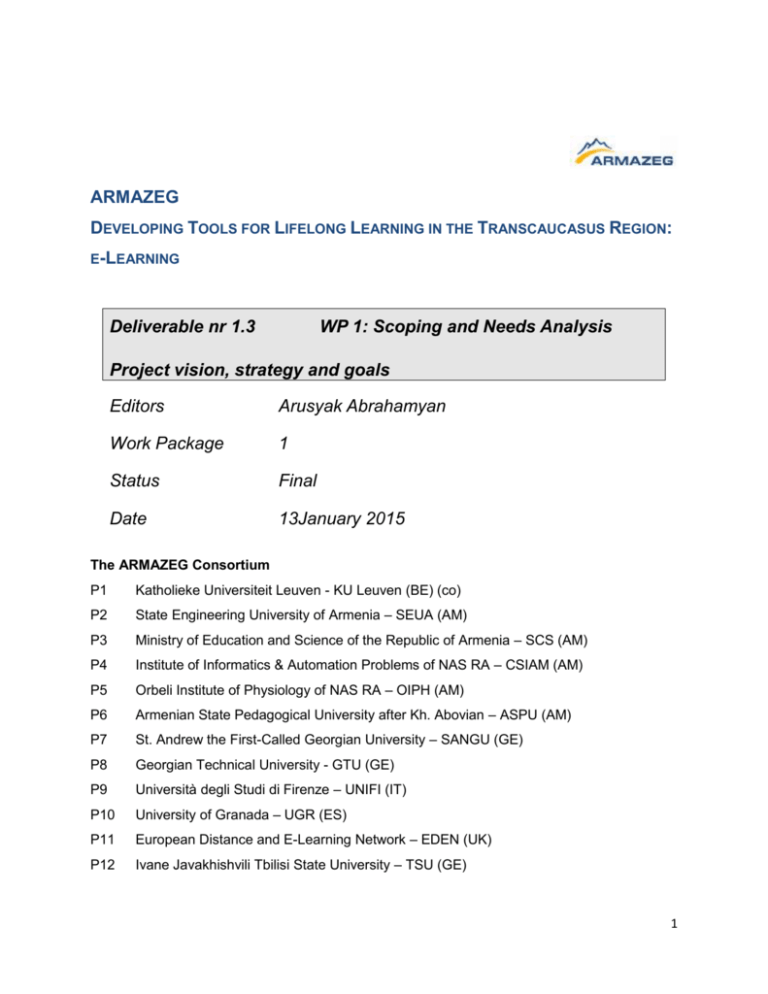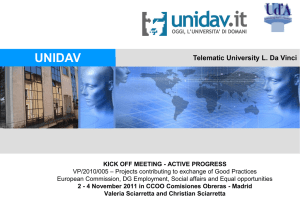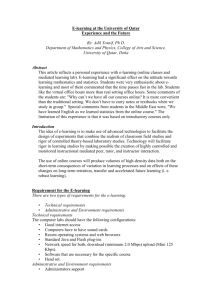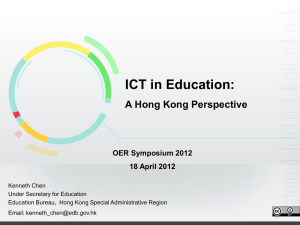here - armazeg
advertisement

ARMAZEG DEVELOPING TOOLS FOR LIFELONG LEARNING IN THE TRANSCAUCASUS REGION: E-LEARNING Deliverable nr 1.3 WP 1: Scoping and Needs Analysis Project vision, strategy and goals Editors Arusyak Abrahamyan Work Package 1 Status Final Date 13January 2015 The ARMAZEG Consortium P1 Katholieke Universiteit Leuven - KU Leuven (BE) (co) P2 State Engineering University of Armenia – SEUA (AM) P3 Ministry of Education and Science of the Republic of Armenia – SCS (AM) P4 Institute of Informatics & Automation Problems of NAS RA – CSIAM (AM) P5 Orbeli Institute of Physiology of NAS RA – OIPH (AM) P6 Armenian State Pedagogical University after Kh. Abovian – ASPU (AM) P7 St. Andrew the First-Called Georgian University – SANGU (GE) P8 Georgian Technical University - GTU (GE) P9 Università degli Studi di Firenze – UNIFI (IT) P10 University of Granada – UGR (ES) P11 European Distance and E-Learning Network – EDEN (UK) P12 Ivane Javakhishvili Tbilisi State University – TSU (GE) 1 Document Control Title: D1.3_final.docx Authors and Editors: Arusyak Abrahamyan E-mail: Amendment History Version Date Author/Editor Description/Comments 1 04.11.2014 Mariet First outline of deliverable. 04.11.201413.01.2015 Arusyak, Tsaghik, 2. Ani Compilation of all the materials and necessary information from partners, edition and elaboration of final version of deliverable. 3. 17.11.2014 Rita Short explanation of strategic goals 4. 17.11.2014 Ramaz Amendments to the first outline of deliverable 5. 14.11.2014 Naira Some opinions and suggestions input 6. 20.11.2014 Liana Some opinions and suggestions input 7. 18.11.2014 Edita, Aram Amendments to the first outline of deliverable 8. 15.11.2014 Paata Amendments to the first outline of deliverable 9. 20.11.2014 Tamar Amendments to the first outline of deliverable 2 Contributors Name Organisation Mariet Vriens KU Leuven Arusyak Abrahamyan, Tsaghik Hovhannisyan, Ani Akelyan SEUA Mariana Sargsyan SCS Edita Gzoyan, Aram Mirzoyan IIAP Naira Ayvazyan, Liana Davydova OIPH Rita Gevorgyan ASPU Hamlet Meladze, Paata Gogihvili SANGU Ramaz Botchorishvili TSU Tamar Lominadze GTU 3 PROJECT VISION, STRATEGY AND GOALS Deliverable 1.3 Work package 1: Scoping and Needs Analysis ARMAZEG has been funded with support from the European Commission. This deliverable reflects the views only of the author, and the Commission cannot be held responsible for any use which may be made of the information contained therein. 4 The ARMAZEG vision The ARMAZEG vision is of a future in which higher education institutions in Armenia and Georgia will use technology to enhance education for students and lifelong learners. More specifically e-learning will serve as an important tool: To ensure a flexible organization of and easy access to learning. To improve the learning process by supporting activating teaching methods. To support research-based education. To support the internationalization of higher education. To facilitate the process of lifelong learning in Armenia and Georgia. Strategic goals The goals that need to be achieved in order for this vision to be realized: SG 1: To have an established policy on e-learning on institutional and national level. In order to have an established policy on e-learning, e-learning has to be incorporated into the education legislationi. A start can be made here by many higher education institutions to include current e-learning practice explicitly in their educational programs. The main emphasis in these policies can be on the sustainability of e-leaning which will become an integrated part of education. The main achievements will be: - Legislation, recognition. - Accreditation for online-learning. - Centralized governance, funding based on central policies. SG 2: To have implemented strategies on institutional and national level concerning the provision of Life Long Learning (LLL) through e-learning methodologies This strategic goal will be realized if Life Long Learning supports professional orientation. 5 Life Long Learning reaches and support people in rural regions, using modern ICT technologies. Life Long Learning offers learning courses for people of local minorities. Life Long Learning strategies exist on the institutional level. Life Long Learning provides accessibility of education (students with disabilities, minority students, students from a lower socio-economic background, students from rural areas or geographically isolated areas, including educational services for a large Armenian and Georgian Diaspora). SG 3: To have established and shared pedagogical models for e-learning This goal will be realized if: There is a shared understanding and use of modern pedagogical models and if certified courses and modules are being developed suitable for elearning and in accordance to these models.ii E-learning resources are implemented to enhance the quality of teaching and learning in accordance to European standards.iii SG 4: To have a shared quality framework for e-learning It is very important to form a joint framework for e-learning that will help: To develop procedures in order to assure the quality e-learning. As a background "Open ECB Check" or "Caucasus e-Learning Quality checklist" could be used; To have shared quality framework model based on the models of European colleagues’ experience, using Moodle platform and improve quality of education and raises educational standards by contributing to an innovative and modern educational system To contribute to deepening the cooperation and to fulfillment of the strategic goals. To facilitate the process of self-assessment of e-learning in Armenian and Georgian partner organizations. SG 5: To have staff qualified to implement e-learning on a technical and pedagogical level There are two pillars of the future sustainable success for e-learning in each organization, namely: appropriate infrastructure and qualified staff. In its turn 6 qualified staff divided in two parts: technical and pedagogical. Availability of staff qualified in both these areas and a close cooperation between them are prerequisites of sustainable success. The cooperation with international/European partners, their experience at this point can be crucial. Therefore, by getting above mentioned strategic goal it will give opportunities: To provide sustainable capacity building on institutional level. To provide high quality in-service training and training material for teachers (preferably via e-learning “teach as you preach”). To conduct regular webinars with the colleagues and professionals in the field of e-Learning and LLL.iv To have qualified staff both technical and pedagogical with appropriate accreditation. SG 6: To have the right infrastructure to enable optimal use of e-learning It is not possible to provide high qualified and modern education without the necessary infrastructure. As the right infrastructure it is considered: A dedicated space, with all the necessary equipment for ICT center. To have the appropriate hard- and software, together with the technical staff trained to use it. To have a right structured computer networks for the effective communication, internet connection with appropriate speed and bandwidth, mobile communication opportunities and all other communication components necessary for e-learning. SG 7: To provide research-based education with the help of ICT-tools Research-based education can become a very effective methodology to support learning processing particular conditions. ICT-tools provide a certain level of independence and flexibility in the educational process. They also enable a wide cooperation between students, teachers and researchers. The use of online tools to support research-based education will support: The creation of online communities connecting students and experts The organization of guest lectures by experts from all over the world through video or web conferencing The involvement of alumni and others into continuing education to link research and education The creation of store of electronic courses. 7 SG 8: To implement the principles of virtual mobility on the level of courses and curriculums Virtual mobility, or ICT supported cross-border interaction, enables students to have international and intercultural experiences without having to travel physically. VM will be implemented on the level of courses and curriculums to support internationalization at home strategies. VM will be recognized as an integral part of the institution’s internationalization strategy. VM will also contribute to a solution for the problem of native education for Armenian and Georgian Diaspora. SG 9: To have strong national and transnational collaboration Sustainability is the most important strategic issue for education. National and transnational collaboration is one of the best ways for solving this problem. The organizations aiming at sustainability can form the base for such kind of collaboration. From this aspect cooperation is important: To rise the role of national and transnational networks, involve all the possible and potential networks or to establish new networks or alliances with the same orientation or joint benefits. To establish the existing base of all the resources, educational materials, staff, infrastructure. To generate joint National Learning Management Systems in Georgia and Armenia which can be the best environment for national and regional cooperation. Operational goals The operational goals are the goals we want to realize during the course of the ARMAZEG project. All these goals fit within the bigger framework of the strategic goals and can be seen as (first) steps in the realization of these strategic goals, and therefore thus of the ARMAZEG vision. SG 1: To have an established policy on e-learning on institutional and national level + SG 2: To have implemented strategies on institutional and national level concerning the provision of lifelong learning through e-learning methodologies 8 OG 1: To establish e-learning centers in 7 universities with a sustainable business strategy. The mission of these e-learning centers will be to help realize the ARMAZEG vision, to elaborate and implement e-learning related institutional policy. It is possible also to establish a joint e-learning consultancy center to help participating or other organizations in creating of electronic courses and using LM systems. OG 2: to promote and disseminate the ARMAZEG vision and approach on the institutional level. Target groups: teaching and administrative staff, decision makers and students. OG 3: directed actions towards policy makers on the national level (e.g. National Accreditation Board in Georgia). OG 4: to promote and disseminate the ARMAZEG vision and approach via the national and transnational e-learning networks. SG 3: To have established and shared pedagogical models for e-learning OG 5: to build capacity via sharing of expertise with European and local partners. OG 6: to develop training material and provide teacher training based on shared models of student centered, activating teaching methods. OG 7: to realize pilot projects based on shared pedagogical models. SG 4: To have a shared quality framework for e-learning OG 8: to develop a quality framework for e-courses. OG8*. To develop and implement a certification procedure for e-learning modules and entire courses. OG8**. To modify existing course syllabuses in accordance to the developed quality assurance and accreditation requirements. OG 9: to promote and disseminate the developed quality framework on institutional and national level. SG 5: To have staff that is qualified to implement e-learning on a technical and pedagogical level 9 OG 10: To provide local training for technical staff. OG 11: To train staff of e-learning centers in teacher training. OG 12: To organize local teacher training. OG 13: To develop training material for teaching staff. OG 14: To develop a sustainable model for capacity building in the partner institutions. SG 6: To have the right infrastructure to enable optimal use of e-learning OG 15: To evaluate existing infrastructure and infrastructural needs of project partners. OG 16: To purchase and install new equipment (together with OG 10: to provide local training for technical staff). SG 7: To provide research-based education with the help of ICT-tools OG 17: To share expertise and provide training in this field via training material and teacher training. SG 8: To implement the principles of virtual mobility on the level of courses and curriculums OG 18: To share expertise and provide training in this field via training material and teacher training. OG 19: to start a dialogue and implement a preliminary base for mobility. Especially virtual mobility among project partner universities. 10 SG 9: To have strong national and transnational collaboration OG 20: To involve national and transnational e-learning networks in the project through promotion, conferences and continuous presentation of the project at the networks events; OG 21: To look at the possibilities of collaboration between project partners, after the end of the project. iIn 1991 the independent Armenia faced the necessity of transforming the education system and developing a new education policy. The main phases of the reforms are the following; 1991-1995: Creation of the foundation of a national school, first-priority reforms, 1995-1998: Establishment of the state administrative system (adoption of the Constitution and a number of laws) 1998: Passing of the RA law “On Education” 2001-2005: Drafting and adoption of the law “On the Approval of the State Program for Education Development for 2001-2005” 2003-2009: Implementation of the first project, “Quality and Compliance of Education”, with the World Bank assistance 2011-2015: Adoption of the law “On the Approval of the RA State Program for Education Development for 20112015. The main issues were solved when Armenia joined the Bologna Process in 2005. That period included a series of ministerial meetings and agreements between European countries designed to ensure comparability in the standards and quality of higher education qualifications. Currently development of interactive e-learning and its widespread dissemination become a main priority of Government policy (http://www.gov.am/files/docs/77.pdf). It focuses on meeting individual student learning needs with the help of technologies. E-Learning is a modern technology-based learning process, or part of the learning process organized for the persons on the territory of Georgia, which doesn’t involve simultaneous presence of teachers and learners at the designated place. To implement e-Learning process it is necessary to use relevant approaches and methods of curricula planning, organization of the learning process and administration. 1. E-learning assumes a learning process is conducted using a learning management system. Learning Management System is a web-based computer program that is required in order to organize and run Technology-based learning process. In particular, LMS is used for a learning materials delivery, student and / or teacher communication, testing, counseling, student progress monitoring, etc. 11 2. E-learning is implemented in an asynchronous and / or synchronous form of communication. Asynchronous communication means interaction, when the sender and receiver of information are not communicating in the real time, and synchronous - when the communication is conducted in the real time. 3. E-learning program is built in accordance with the requirements established by law for higher education programs. After the completion, a person is assigned appropriate qualification and is issued a corresponding document. 4. Students for E-learning program can be enrolled only at the first and second levels of the Higher education, in accordance with the procedure established by Chapter VIII of this law. ii Universities aim to provide relevant high quality academic programmes are based on innovative educational processes and the implementation of new teaching methods with the application of appropriate technologies. Learning and teaching processes should adapt existing methods and techniques, adopt new ones and focus on the achievement of learner outcomes. It also requires universities to create a positive learning environment by delivering effective educational practices. The Flipped Learning model can solved above mentioned issues and enable educators to make the shift from teacher-driven instruction to student-centered learning. Flipped Learning model enables teachers with the help of technologies move direct learning into the individual learning space. The videos are available for students to access whenever and wherever it is convenient for them. The priority of the model is that Flipped classrooms allow to use a variety of learning modes; group work, independent study, research, performance, and evaluation and more actively involve students in the learning process. From the other side the Flipped Learning model can help to become more effective as teachers and increase students’ conceptual understanding. The Flipped Learning model provides that bridge to a learner-centered classroom environment. iii ClassroomWindow and Flipped Learning Network. (2012). Flipped Classrooms: Improved test scores and teacher satisfaction. Retrieved from Classroom Window website: http://classroomwindow.com/ Driscoll, Tom. (2012). Flipped Learning and democratic Education: The Complete Report. Retrieve from http://www.flipped-history.com/2012/12/flipped-learning-democratic-education.html Objectives of this European standards are: Approximate education quality assurance tools to the European standards. Allocate new e-learning resources to support academic programs’ development and evaluation. Involve academic faculty with appropriate skills in e-learning delivery process. Develop criteria for assessment of effectiveness of e-learning. iv Sustainability, effectiveness, efficiency, compatibility of the e-learning Centre, assumptions and risks are the components that need to be analyzed before developing the strategy. The key elements for enhancing the quality of education are infrastructure, human resources, curricula, the content of courses, e-materials. Extensive and continuous training of teachers should allow for a better adaptation of new educational methodologies, enhanced by ICT. Beside the trainings there are several other ways in which teacher professional development is carried out throughout the; Conferences. Qualification programs. Observation visits to partner universities. Participation in teacher networks. Individual or group research projects. Mentoring. 12







